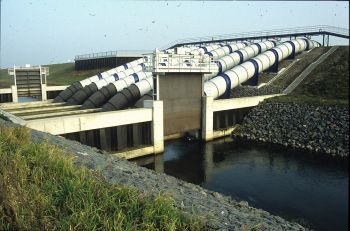Siphon Spillways

|
| Siphon Spillway, 1990.
(Image Source: Armbruster, Bundesanstalt für Wasserbau) |
“These types of control structures are suited for service, auxiliary and emergency spillways, and/or outlet works. Siphon spillways have been used to help pass excess inflows (i.e., augment other hydraulic structure discharge capacity). These spillways can be designed to be self-priming or manually primed. The siphon has relatively small discharge capacity (pressurized operations), limited ability to drain the reservoir (limited hydrostatic head to less than atmospheric pressure, or about 30 feet), and is generally not suitable for cold weather climates (i.e., susceptible to ice blockage). Examples of siphon spillways include the auxiliary spillway at Reclamation’s McKay Dam (embankment) and the service spillway at Reclamation’s Salmon Lake Dam (embankment). Also, siphon spillways have been used to provide discharge capacity for small embankment dams to augment or replace existing outlet works. Considerations include fairly rapid installation involving shallow excavation through dam crest, and the reservoir does not need to be drained. Examples of siphon spillways include the service spillways at the BIA’s Horseshoe Cienega Dam (embankment) and Tsaile Dam (embankment)."[1]
Citations:
Revision ID: 7465
Revision Date: 07/25/2023
